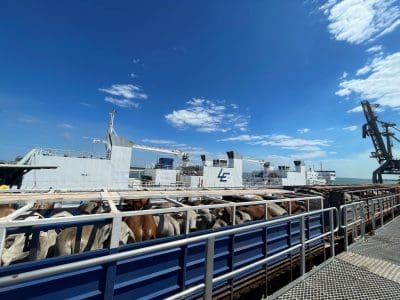A point not widely reported following the deaths of about 150 Australian cattle on a livestock shipment to Indonesia last week is that about 50 cattle from the same property also died at the same time in the pre-export yards near Darwin.
Clinical signs are pointing to the likelihood that cattle died from botulism, having ingested the toxin at some point in the previous two weeks, possibly from contaminated feed or water or chewing on bones.
The simultaneous deaths of cattle from the same property on the ship and in the yards is pertinent, because it demonstrates that the cattle on the ship did not die because they were on a live export ship, which some reporting around the case implies.
A Bloomberg article for example stated that the disease outbreak highlighted “the welfare risks of exporting livestock”.
This overlooks the fact that the cattle died because they were exposed to a toxin somewhere in the environment that infected and ultimately killed them.
Presumably the same cattle would have died wherever they were when the infection took hold – still in a paddock, on a truck, in a feedlot or at a processor’s lairage.
Despite not being a “live export” issue in cause, the incident has led to negative news headlines for the livestock export industry at a time when the Federal Government is seeking justification to support its planned ban on sheep exports.
While the issue has led to a new round of criticism for the industry, it has also publicly highlighted the high degree of scrutiny, monitoring and reporting standards Australia’s livestock export sector is now required to comply with, which are arguably than higher any other agricultural sector in the world.
As many media articles have reported, the deaths of as few as three cattle on a sea journey is the trigger point for a “Notifiable Mortality Incident”.
A notifiable incident requires exporters of livestock to report the event directly to the Australian Government, which then follows with an investigation, and publishes the details and results online.
On longer journeys, and some shorter voyages, exporters are also required to pay the cost, often in the order of tens of thousands of dollars, to have a Government-appointed independent observer travel on their ships to report back to Government through detailed reports which are also published online.
Exporters are also held legally responsible under the Exporter Supply Chain Assurance System (ESCAS) for the welfare and treatment of all exported animals past the point of delivery until the point of death in the destination market.
Continuous traceability standards are also mandatory throughout.
While deaths of Australian cattle from any cause on a livestock export vessel are required to be reported if the number of dead animals exceeds three head, Botulism is not included in the national list of notifiable animal diseases in Australia published on the Department of Agriculture, Fisheries and Forestry website.
A Botulism fact sheet produced by the NT Government indicates that losses of up to 25 percent have been reported in some herds, attributable to lack of vaccine or vaccination failure which can result from several factors.
It notes that C.botulinum occurs in soil, water and marine sediments worldwide, and in the gut flora in many healthy horses, cattle and poultry.
The bacterium thrives in decaying animal or plant material and produces spores, which can survive in the environment for a long time. The spores germinate in moist, low-oxygen environments such as rotting carcasses or other organic matter. The spores produce botulinum toxin, which leads to intoxication of susceptible animals when consumed. All animal species can be affected, but cattle are among the most susceptible animals with respect to mortality (More information in PDF here).




There are three points to be made:
1) if this high mortality event happened on land there would be a veterinarian available (maybe a number of hours away but at least available for teleconferencing etc) not to mention the relevant state Ag Department. Instead there was a stockperson who has done a four day certification course and has no training, experience or expertise in disease outbreak investigation or management – as the Australian Veterinary Association said “The AVA believes that the Australian Standards for the Export of Livestock (ASEL) regulatory controls are deficient” in not requiring a veterinarian on every voyage.
2) if it happened on land, the animals would be on a stable surface with adequate space to all lie down, not surrounded by high decibel noise and ammonia fumes exacerbating any illness or the misery of it.
3) botulism has not been confirmed as a diagnosis – it is notable that the NT Chief Veterinary Officer urged “caution about the diagnosis” and NT producers with “lived experience” of botulism on their properties arent buying it (ABC NT Country Hour: https://www.abc.net.au/listen/programs/nt-country-hour/chief-vet-nt-cattle-deaths-on-live-export-ship/103641020). Somehow, when the non-veterinarian head of ALEC says it is botulism based presumably on the opinion of a non-veterinarian stockperson, everyone seems to think that is a confirmed veterinary diagnosis. VALE will be surprised if botulism is confirmed.
If live export is banned from Australia importing countries will source their animals from countries that have no animal ethics standards. Counter productive.
This could also end up making the quarantine period longer.